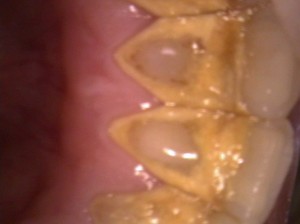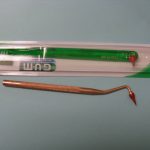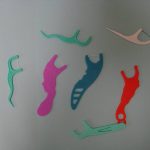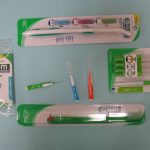Flossing is important but flossing is also hard
Flossing is important, but lets admit it, flossing is a pain; difficult even for professionals. We all know cleaning in between the teeth is important and a toothbrush does not get to these surfaces. Using string floss between two fingers is a manual dexterity skill that few truly master. Crooked teeth, fat fingers, tight contacts, boney anatomy and small mouths all contribute to the difficulty of flossing. We will do everything we can to help you learn, but the reality is that most people do not floss even after learning how. This is one of the reasons that gum disease is one of the most common diseases.
Why Can Some people can get away without flossing?
 We don’t know nor can we predict who the lucky ones are. We do know that cleaning in between the teeth is a good idea simply to prevent bad breath. Few would ever think of not brushing their teeth for a week and then attempting to kiss someone. I am not attempting to diminish the importance of floss, I am simply facing the reality of thirty years of dental practice. Our job is not to berate or belittle you if you do not floss but to look for ways to help you to get in between your teeth and clean. In many situations floss may not be the best tool to clean a specific area and in the end the goal is to get in between the teeth and disturb the bacteria so they can not cause destruction. As long as we accomplish this goal we do not care how we do it.
We don’t know nor can we predict who the lucky ones are. We do know that cleaning in between the teeth is a good idea simply to prevent bad breath. Few would ever think of not brushing their teeth for a week and then attempting to kiss someone. I am not attempting to diminish the importance of floss, I am simply facing the reality of thirty years of dental practice. Our job is not to berate or belittle you if you do not floss but to look for ways to help you to get in between your teeth and clean. In many situations floss may not be the best tool to clean a specific area and in the end the goal is to get in between the teeth and disturb the bacteria so they can not cause destruction. As long as we accomplish this goal we do not care how we do it.How to floss
- Wind 15-18 inches of floss around your middle fingers (This allows you to control the floss with your forefinger and thumb).
- Gently guide floss between teeth to the gun line.
- Try not to snap the floss through the contact as you can actually damage the gum.
- Curve the floss to contact as much of the tooth as possible.
- This will clean the surfaces of the tooth.
- Gently move the floss up and down.
- Do not saw back and forth you can damage the gum and actually even saw into the tooth.
- Use a fresh piece section of floss for each tooth (No reason to spread bacteria from one place to another).
Alternatives to floss
Here are some of the other tools we recommend:
Rubber tips:
 I have very crooked lower teeth, thanks to my refusal to wear braces as a child. I have found the best tool for me is the pointy rubber tip that many take off so the brush can fit in the toothbrush holder. I am able to get into areas that brushing and flossing can’t reach. Being able to manipulate it around corners makes it one of my favorite alternatives to floss.
I have very crooked lower teeth, thanks to my refusal to wear braces as a child. I have found the best tool for me is the pointy rubber tip that many take off so the brush can fit in the toothbrush holder. I am able to get into areas that brushing and flossing can’t reach. Being able to manipulate it around corners makes it one of my favorite alternatives to floss.Floss holders:
 Numerous styles of floss holders have been developed and many of our patients, including my wife, find them to be much easier because you only have to use one hand. Just because one style doesn’t work for you do not give up. Each company makes its own design and often offer the added benefit of a small plastic pick attached that allows you to get into areas you can not floss.
Numerous styles of floss holders have been developed and many of our patients, including my wife, find them to be much easier because you only have to use one hand. Just because one style doesn’t work for you do not give up. Each company makes its own design and often offer the added benefit of a small plastic pick attached that allows you to get into areas you can not floss.Tooth picks and small inter-dental brushes:
 For some patients with large spaces between their teeth floss is a very inefficient way to clean. In these cases small inter dental brushes with different shapes can fit in between the teeth and brush and clean the surfaces much more thoroughly.
For some patients with large spaces between their teeth floss is a very inefficient way to clean. In these cases small inter dental brushes with different shapes can fit in between the teeth and brush and clean the surfaces much more thoroughly.Automatic toothbrushes:
Some automatic toothbrushes have pointy tips that can be useful, but may not be able to reach the most difficult areas in between the teeth.
Types of floss:
For the traditionalists who insist on using string floss there are many different types of available with different thicknesses and types of string materials. We have found that Glide floss is the easiest to get through tight contacts without shredding and breaking.
Water Picks:
Water picks do not actually disturb all the bacteria between the teeth completely, but they do dilute and remove the toxins produced by the bacteria.
The bottom line is that we have seen each of these methods used by our patients to achieve dental health. It really doesn’t matter how or what we use to get to that goal. The key is to keep trying different methods and let us help you to evaluate if they are working at your cleaning appointments. If floss is getting hung up in between particular teeth let us know because it may indicate a problem like a fractured filling, broken tooth or decay.
The dangers of do it yourself hygiene
Finally for all you wannabe dentists and hygienists who use metal instruments bought or created to clean your teeth I offer this cautionary tale. One of my good friends decided he could get the tartar off the back of his front teeth by creating his own dental tool out of a paperclip. He diligently used his tool because he felt a ledge on the back of his lower front tooth. Unfortunately the bump he was trying to remove was his own tooth structure. He managed to dig all the way into the nerve and ended up needing a root canal. Our advice is to let us be the ones who use metal dental tools in your mouth to clean your teeth.
